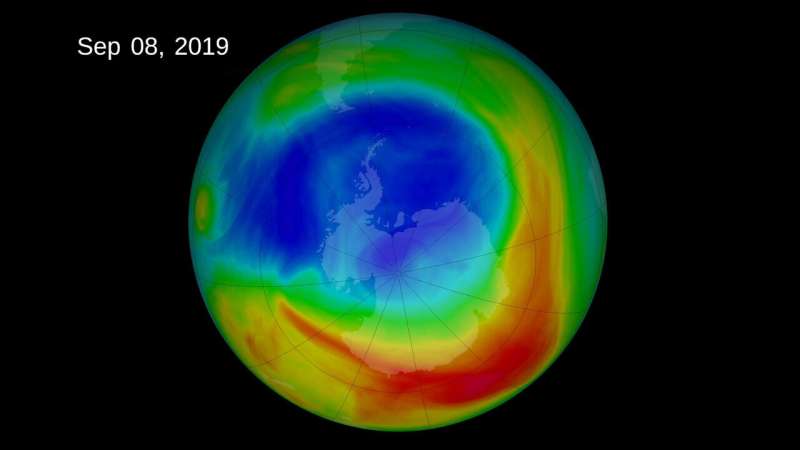This article has been reviewed according to Science X's editorial process and policies. Editors have highlighted the following attributes while ensuring the content's credibility:
fact-checked
peer-reviewed publication
reputable news agency
proofread
Antarctic ozone hole getting deeper in mid-spring, research suggests

The hole in the Antarctic ozone layer has been getting deeper in mid-spring over the last two decades, despite a global ban on chemicals that deplete Earth's shield from deadly solar radiation, new research suggested Tuesday.
The ozone layer 11 to 40 kilometers (seven to 25 miles) above Earth's surface filters out most of the sun's ultraviolet radiation, which can cause skin cancer and cataracts.
From the mid-1970s, chemicals called chlorofluorocarbons (CFCs)—once widely used in aerosols and refrigerators—were found to be reducing ozone levels, creating annual holes largely over the Antarctica region.
The 1987 Montreal Protocol, which banned CFCs in a bid to close the hole, is considered a success story for international environmental cooperation.
In January, a major UN-backed assessment found that the agreement was working. It projected the ozone layer should be restored to 1980 levels over the Antarctic by around 2066.
Smaller holes over the Arctic were projected to recover by 2045, and for the rest of the world in around two decades.
But despite the decline in CFCs, there has not yet been a significant reduction in the area covered by the Antarctic ozone hole, according to New Zealand researchers behind a new study in the journal Nature Communications.
And there has been less ozone at the center of the hole over time, they added.
"Six of the last nine years have had really low ozone amounts and extremely large ozone holes," study co-author Annika Seppala of New Zealand's Otago University told AFP.
"What might be happening is something else is going on in the atmosphere now—possibly because of climate change—and that's masking some of the recovery," she said.
An unusual few years
The ozone hole over Antarctica usually opens in September and lasts until November, taking in the Southern Hemisphere's spring.
The researchers said the hole has been opening later in September, indicating a recovery possibly due to CFC reductions.
But in October, when the hole is often largest, the ozone level in the middle stratospheric layer shrunk by 26 percent from 2004 to 2022, said the study, citing satellite data.
The study's lead author Hannah Kessenich emphasized that the Montreal Protocol and CFC reductions were still "on track".
But "altogether, our findings reveal the recent, large ozone holes may not be caused just by CFCs," she added.
The analysis excluded data from the years 2002 and 2019, when "sudden break-ups of the polar vortex" led to significantly smaller ozone holes, Kessenich added.
Leading ozone scientist Susan Solomon, who was not involved in the research, told AFP that the study should be viewed through the lens that "the past few years have been quite unusual".
Solomon led previous research showing that 2020's ozone hole was made 10 percent wider by the massive "Black Saturday" wildfires in Australia.
The gigantic eruption of the Hunga-Tonga-Hunga-Ha'apai volcano off Tonga in 2022 is also believed to have affected recent ozone levels.
Martin Jucker, an expert at Australia's University of New South Wales, was not convinced by the study's results.
"It is questionable how the authors can remove 2002 and 2019 from the record but not 2020-22, given that all of these years have been shown to be dominated by very special and rare events," he said.
More information: Hannah E. Kessenich et al, Potential drivers of the recent large Antarctic ozone holes, Nature Communications (2023). DOI: 10.1038/s41467-023-42637-0
Journal information: Nature Communications
© 2023 AFP





















